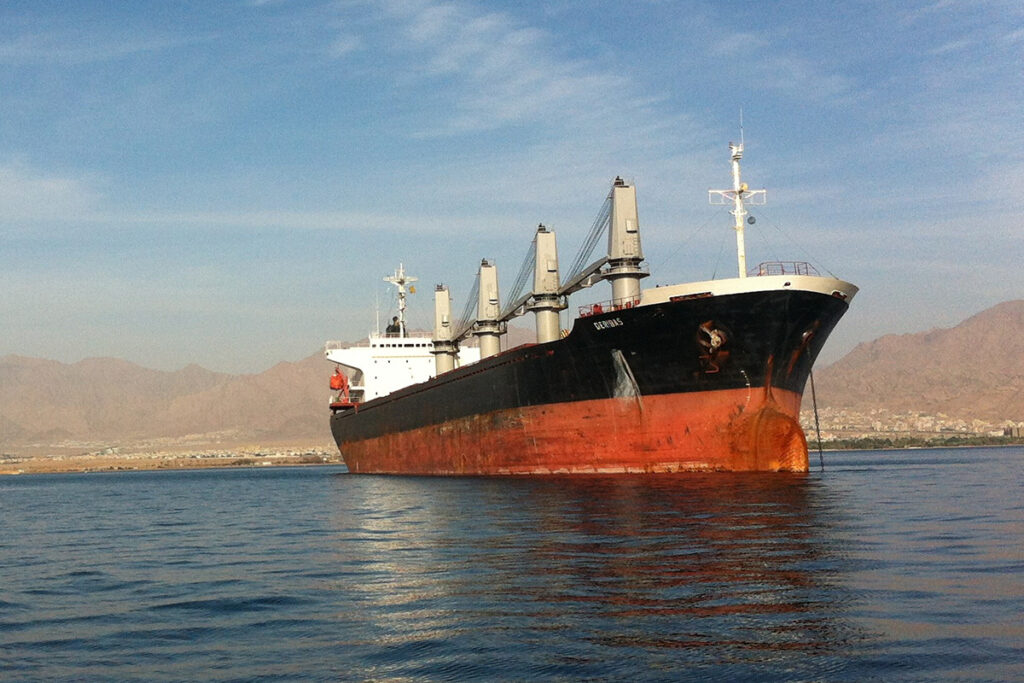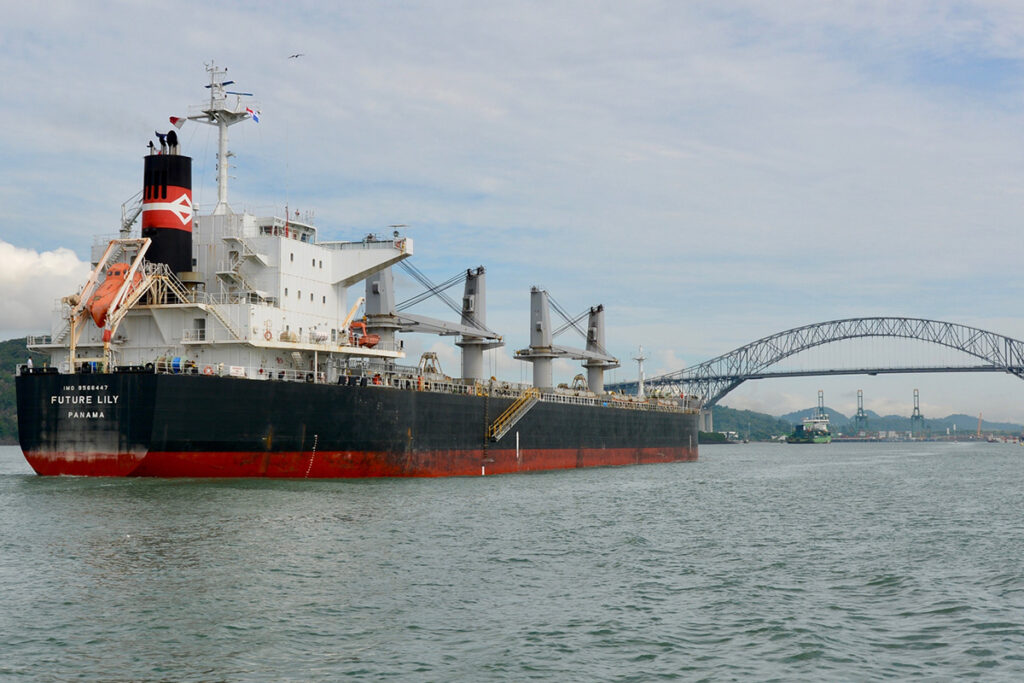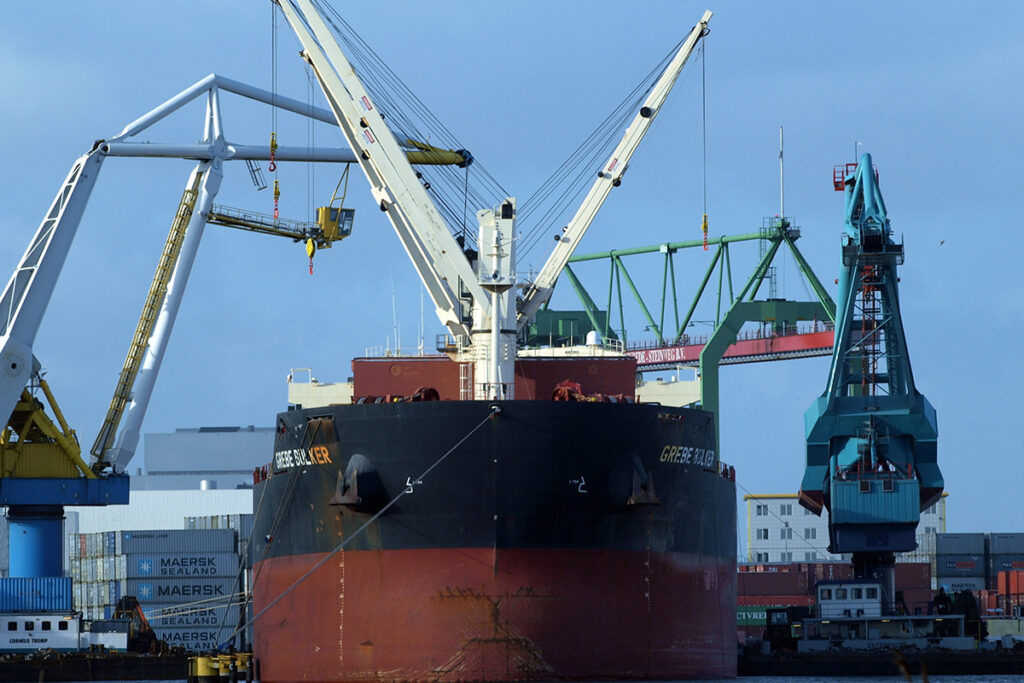The Ultramax bulk carrier is a popular vessel type that is commonly used to transport dry bulk cargoes such as coal, iron ore, grain, and fertilizer. With its size and cargo capacity falling between that of Supramax and Panamax vessels, the Ultramax has gained significant popularity among shipowners and operators.
In this article, we will explore the Ultramax bulk carrier in detail, covering its dimensions, cargo capacity, cost, uses, and other key features. Whether you’re a shipping industry professional or simply interested in learning more about ships, this article will provide you with a comprehensive guide to the Ultramax bulk carrier.
So, let’s dive in and discover all there is to know about this impressive vessel. If you’re interested in learning more about the world of maritime transport, check out our blog on “The Future of Shipping Technology” and “Rotor Sails On Ships” to dive deeper into this fascinating topic.

What is an Ultramax Bulk Carrier?
An Ultramax bulk carrier is a type of ship that is designed to transport dry bulk cargo, such as coal, grain, and iron ore. These vessels are categorized as medium-sized bulk carriers, with a deadweight tonnage (DWT) ranging from 50,000 to 65,000.
The term “Ultramax” was coined by Japanese shipbuilder Imabari Shipbuilding in 2006 to describe the latest generation of bulk carriers that are larger than Supramax vessels but smaller than Panamax vessels. Ultramax bulk carriers have since become a popular choice for shipping companies due to their versatility and efficiency.
Typically, Ultramax vessels have five cargo holds and four cranes, which enable them to load and discharge cargo quickly and efficiently. The dimensions of Ultramax ships vary, but they are usually around 200 meters in length, 32 meters in width, and 18 meters in depth.
Ultramax bulk carriers are built with modern technologies and advanced features that enhance their efficiency and safety. These features include ballast water treatment systems, fuel-efficient engines, and advanced navigation and communication systems. Overall, the Ultramax bulk carrier is a reliable and cost-effective vessel that plays a crucial role in the global shipping industry.

Ultramax Dimensions and Cargo Capacity Number of Holds
The Ultramax bulk carrier has a length ranging from 190 meters to 300 meters, a width of around 32 meters, and a depth of up to 20 meters. These dimensions allow the vessel to carry a maximum deadweight tonnage (DWT) of between 50,000 to 65,000 metric tons, depending on the specific design.
Ultramax bulk carriers are equipped with five to seven cargo holds, with each hold having its own hatch cover. The holds are typically designed with box-shaped holds that allow for efficient loading and unloading of dry bulk cargoes. The cargo capacity of an Ultramax vessel varies depending on the size and design, but it can typically carry up to 80,000 cubic meters of cargo.
In addition to the cargo holds, Ultramax bulk carriers are equipped with a range of cargo handling equipment, including cranes, conveyors, and grabs, which enable efficient loading and unloading of cargo. The cranes are typically located on the ship’s deck and can be operated remotely by the ship’s crew.
Overall, the dimensions and cargo capacity of the Ultramax bulk carrier make it a versatile and efficient vessel that is well-suited for transporting a wide range of dry bulk cargoes.
How Much Does an Ultramax Ship Cost?
The cost of an Ultramax bulk carrier can vary widely depending on a range of factors, including the shipyard building the vessel, the ship’s specifications and design, and the current market conditions.
As of 2023, the cost of a new Ultramax bulk carrier is estimated to be between USD 25 million to USD 40 million, depending on the specific design and features. However, the price can go higher if the vessel includes additional features such as eco-friendly systems or advanced technology for fuel efficiency and safety.
In addition to the initial purchase cost, operating and maintenance costs also need to be considered when evaluating the total cost of owning an Ultramax bulk carrier. These costs include fuel, crew, insurance, and maintenance expenses.
Despite the high initial cost, Ultramax bulk carriers are considered a valuable investment for dry bulk shipping companies due to their efficiency, versatility, and cargo-carrying capabilities. The vessel’s design and modern features contribute to lower fuel consumption and operational costs in the long run, which can make them a profitable option for shippers.

Ultramax Bulk Carrier Uses and Advantages
Ultramax bulk carriers are primarily used to transport dry bulk cargoes such as coal, iron ore, grain, and fertilizers. These vessels are ideal for carrying large quantities of dry bulk cargo over long distances, making them a crucial component of the global shipping industry.
One of the advantages of Ultramax bulk carriers is their versatility. The vessels are designed to carry a wide range of dry bulk cargoes, making them suitable for use in various industries such as mining, agriculture, and construction. The vessels are also able to navigate through narrow waterways and ports, which makes them more accessible than larger vessels such as Capesize ships.
Another advantage of Ultramax bulk carriers is their fuel efficiency. Modern Ultramax vessels are built with advanced technologies that help reduce ship fuel consumption per mile and lower greenhouse gas emissions. This makes them a more environmentally friendly option compared to older vessels.
Ultramax bulk carriers are also designed with safety features that help protect the crew, cargo, and the environment. The vessels are equipped with advanced navigation and communication systems, as well as ballast water treatment systems that help prevent the spread of invasive species.
Overall, the Ultramax bulk carrier is a reliable and efficient vessel that offers a range of advantages to shipping companies. Its versatility, fuel efficiency, and safety features make it a popular choice for transporting dry bulk cargoes around the world.
Ultramax Gross Tonnage and DWT
Gross tonnage (GT) and deadweight tonnage (DWT) are two important measures used to describe the capacity and size of a vessel, including the Ultramax bulk carrier.
Gross tonnage (GT) is a measure of the total interior volume of a vessel, including all enclosed spaces and compartments. It is calculated based on a formula that takes into account the volume of the vessel’s hull, superstructure, and other spaces. The gross tonnage of an Ultramax bulk carrier typically ranges from 30,000 to 65,000 GT, depending on the specific design and size of the vessel.
Deadweight tonnage (DWT) is a measure of the total weight of cargo, fuel, and supplies that a vessel can carry. It is calculated based on the difference between the loaded and unloaded weight of the vessel. The DWT of an Ultramax bulk carrier typically ranges from 50,000 to 65,000 metric tons, depending on the specific design and capacity of the vessel.
The GT and DWT measures are important considerations for shipping companies when selecting a vessel for a particular transport task. The Ultramax bulk carrier’s GT and DWT capacities make it well-suited for carrying a range of dry bulk cargoes over long distances, while its efficient design and advanced technologies help reduce fuel consumption and environmental impact.
Ultramax Bulk Carrier Size Compared To Other Bulker Sizes.
The Ultramax bulk carrier is a mid-sized vessel type that falls between the Handymax and Panamax categories in terms of size and capacity.
Handymax vessels typically have a capacity of 40,000 to 60,000 DWT and a length of around 190 meters. Ultramax bulk carriers are slightly larger than Handymax vessels, with a capacity of 50,000 to 65,000 DWT and a length of around 200 to 220 meters.
In comparison, Panamax vessels have a maximum length of 294 meters and a capacity of around 65,000 to 80,000 DWT. These vessels are designed to navigate through the Panama Canal and are typically used for transporting bulk commodities such as coal, iron ore, and grain.
While the Ultramax bulk carrier is not as large as the Panamax vessel, it has several advantages over larger vessel types. Its smaller size allows it to access ports with restrictions on draft and length, making it more versatile for transporting bulk cargoes to smaller ports. Additionally, Ultramax vessels have lower fuel consumption and operating costs compared to larger vessels, making them more cost-effective for certain transport tasks.
Overall, the Ultramax bulk carrier occupies a crucial position in the global shipping industry, providing a balance between capacity and versatility that makes it an attractive option for shipping companies.
The Difference Between Ultramax and Supramax Dry Bulk Carriers
Ultramax and Supramax are both types of dry bulk carriers used to transport dry commodities such as coal, iron ore, and grain. However, there are some key differences between the two vessel types.
One of the main differences is size. Ultramax vessels are typically larger than Supramax vessels, with a deadweight tonnage (DWT) range of 50,000 to 65,000, while Supramax vessels have a DWT range of 45,000 to 59,000. This means that Ultramax vessels are capable of carrying more cargo than Supramax vessels.
Another difference is draft. Ultramax vessels have a deeper draft than Supramax vessels, which can limit their ability to access shallower ports. However, Ultramax vessels have a greater cargo capacity, which can make them more efficient for long-distance voyages.
Finally, the design of the two vessel types is different. Ultramax vessels typically have a wider beam and shallower depth than Supramax vessels, which can provide greater stability in rough seas.
Overall, both Ultramax and Supramax vessels are important types of dry bulk carriers, and the choice between them will depend on the specific needs of the shipping company and the requirements of the cargo being transported.
Conclusion about Ultramax Bulk Carriers
In conclusion, the Ultramax bulk carrier is a versatile and efficient vessel type that plays a critical role in the global shipping industry. With its advanced technologies, optimal design, and large cargo capacity, the Ultramax is well-suited for transporting a wide range of dry bulk commodities over long distances. Its mid-sized profile also allows for greater access to smaller ports, providing greater flexibility for shipping companies.
Overall, the Ultramax bulk carrier has become an important vessel type for meeting the growing demand for global trade and transportation. As the shipping industry continues to evolve, the Ultramax is poised to play an even greater role in the years to come.
What is the cargo capacity of an Ultramax bulk carrier?
The cargo capacity of an Ultramax bulk carrier typically ranges from 50,000 to 65,000 deadweight tonnage (DWT).
What is the length of an Ultramax bulk carrier?
The length of an Ultramax bulk carrier typically ranges from 200 to 220 meters.
What is the typical cost of an Ultramax bulk carrier?
The cost of an Ultramax bulk carrier can vary widely depending on factors such as age, condition, and specifications, but generally ranges from $25 to $40 million USD.
What is the advantage of the Ultramax bulk carrier’s mid-sized profile?
The Ultramax bulk carrier’s mid-sized profile allows for greater access to smaller ports, providing greater flexibility for shipping companies.
What types of dry bulk commodities are typically transported on Ultramax bulk carriers?
Ultramax bulk carriers are used to transport a wide range of dry bulk commodities, including coal, iron ore, grain, cement, and fertilizers.
- Sustainable and Luxurious: Discovering Split’s Yachting Paradise – April 26, 2024
- MarineTraffic vs VesselFinder: Which Is Better Vessel Tracking Service? – February 14, 2024
- Port Costs: A Comprehensive Guide to Port Dues and Fees for Cargo Ships – February 12, 2024





Leave a Reply